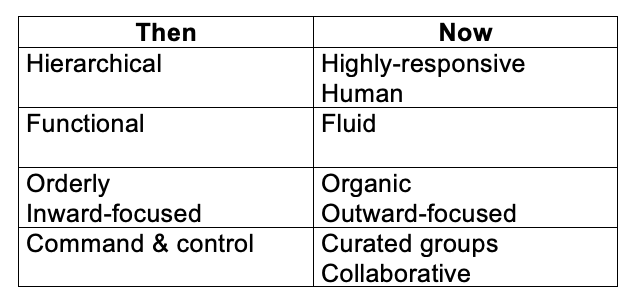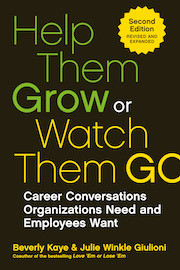Guest Post by Julie Winkle Giulioni
If you lead an organization, work in an organization, or even set foot in an organization, you know that we are living in a time of significant change. Many forces and factors are contributing to these changes, including:
- Competition comes from all parts of the world and from new (and frequently disruptive) sources.
- Escalating customer expectations means that the bar continues to be raised in terms of innovation, quality, and cost.
- Downward pressure on cycle time results in investing extraordinary effort for sometimes incremental improvements.
- Changing workplace demographics offer the most diverse employee population ever, with greater numbers of younger employees who bring different expectations to the job.
- The significant proportion and importance of knowledge work – and the unique challenges associated with managing it.
- Today’s distributed workforce has people making their contributions to the business from far-flung places, day and night.
Old Structures Are No Longer Delivering the Results They Once Did
In response to these changes and challenges, organizations are morphing. Old structures are giving way to new and evolving approaches to organizing people and work for better results.

What used to be rigid and hierarchical is becoming more human and highly responsive to changing business needs. The former focus on functions is evolving to allow for a more fluid exchange of resources as necessary. The orderly structures of the past that reflected an inward-looking orientation are giving rise to outwardly-focused, organic structures. And finally, ‘command and control’ that has characterized business for decades is being replaced with curated groups and far greater collaboration.
But new organizing structures are just the physical manifestation of change. What they can accomplish is highly dependent upon the culture within the organization. New structures quickly disintegrate if culture is not aligned with them.
Blurry Vision Is the New 20-20
Culture is the environment or atmosphere within the organization based on the norms that arise from the ways people treat each other and work together,
In the new structures, the lines of demarcation among and between departments, division, and functions becomes blurry. The culture must shift to support this lack of clarity.
Actually, blurry boundaries are not about confusion or lack of clarity… quite the opposite. When we trade the hard lines and artificial borders that we’ve constructed between departments or divisions, our vision improves, illuminating opportunities to collaborate. When we stop thinking in terms of ‘us’ and ‘them’, we can appreciate and leverage our interconnectedness. When we step out of our traditional boxes and into the broader organizational milieu, we can see, and be part of, the bigger picture. Blurring the boundaries in this way involves a mindset that’s more generous and inclusive – and one that’s focused more broadly on the enterprise as a whole.
The outcome of this cultural shift is:
- Collaboration among groups, teams, departments, and/or divisions naturally flourishes.
- Us’ and ‘them’ language dissipates.
- Resources are frequently and generously shared across departments to accomplish goals.
- Employees are encouraged to look outside of their own areas for opportunities to learn, contribute, and grow.
Development Is At the Center of It All
Successfully transitioning to structures that better address the challenges facing business today is inextricably connected with the role of talent and career development. But what exactly is the relationship? Is development a contributor to or outcome of these structural changes?
Yes, to both! Making the most of the evolving, more organic and fluid structures demands new skills. Collaboration. Listening. Feedback. And that’s just the beginning. Operating effectively without the traditional hierarchical order puts more onus on each employee to step up in different ways, making learning and development non-negotiable.
But these structures tend to enable greater development as well. Leaders who have figured out how to blur boundaries find themselves supporting development in more and different ways. They know how to look more broadly and outside of their own areas for opportunities. Structures might enable it – but it’s a leader’s willingness to move people around and even lose good talent to their colleagues that drives employee development and organizational results.
Blurring the boundaries is good for evolving organizational structures. It’s good for talent and career development. It’s good for your people. And it’s good for the business.
Start by taking a few small steps.
1. Get to know your colleagues in other parts of the business.
2. Find ways to support the efforts of those outside of your own group.
3. Interrupt competition and territorialism before it takes hold.
4. Seek out collaborations with colleagues that offer developmental experiences for your employees.
 This guest post was written by Julie Winkle Giulioni in celebration of the release of the 2nd Edition of her Washington Post bestseller Help Them Grow or Watch Them Go: Career Conversations Organizations Need and Employees Want, written with co-author Bev Kaye. Julie works with organizations worldwide to improve performance through leadership and learning. Named one of Inc. Magazines top 100 leadership speakers, she offers keynotes, workshops, custom webinars, elearning and microlearning solutions that deliver measurable results. Julie is a regular contributor to The Economist, SmartBrief, Saba’s TalentSpace, the Conference Board’s Human Capital Exchange, and offers thoughts on leadership, career development, and more via her blog www.juliewinklegiulioni.com.
This guest post was written by Julie Winkle Giulioni in celebration of the release of the 2nd Edition of her Washington Post bestseller Help Them Grow or Watch Them Go: Career Conversations Organizations Need and Employees Want, written with co-author Bev Kaye. Julie works with organizations worldwide to improve performance through leadership and learning. Named one of Inc. Magazines top 100 leadership speakers, she offers keynotes, workshops, custom webinars, elearning and microlearning solutions that deliver measurable results. Julie is a regular contributor to The Economist, SmartBrief, Saba’s TalentSpace, the Conference Board’s Human Capital Exchange, and offers thoughts on leadership, career development, and more via her blog www.juliewinklegiulioni.com.














This is a terrific post and I’d love a copy of the book, Julie. In fact, I wish I’d written it. I just got off the phone with a development director struggling with the very territorialism you mentioned, and I would have loved to point her to your book. Your perspective on culture and the direction in which teams need to move to achieve collaborative leadership is insightful and refreshing.
Excellent points! I would like to win a copy of Help Them Grow.
Working across these boundaries is always a challenge as each organisation has its own culture but good leadership and management should be universal. Thank you may I please have a copy of Help Them Grow .
I’d like a copy of Julie’s book. Thank you!!
This post is spot-on and directly answers the kind of challenges we have at my work place. We are organised in three distinct Components, but all contributing to one single goal and yet we are not collaborating well at all. Each component is holed up in its own “territory” with very poor cross-component communication and exchange of ideas. We are not being very productive. This has to change. This post could be a huge input into our quest for changing our ways. I would love to have an electronic copy
So glad it might be helpful, Martin. Recognizing the challenge is the first step. Then it’s a matter of helping leaders and employees alike think and behave differently. As you’ve identified, communication is key… as well as really ensuring that everyone understands the work/contributions of the different components. Best of luck to you.
Im retired but very invloved in my Unitarian church now. I see the need for these shifts there. The old hierarchies and committees don’t work for younger members or even busy retirees like me. Thank you. I forwarded this to our Revs and Board President.
Genuine, healthy collaboration is essential. Love the title. As leaders we can be proactive with a servants heart or we can stand back and let it happen without us. Like a garden. We can provide fertile soil, ongoing nourishment and weed control or we can throw seeds at any patch of soil and hope for the best. Help or watch. The choice is ours. Thanks!
Great point, Marye. Many human systems are experiencing the shift and need to facilitate the necessary adjustments to ensure engagement, development and results!
Incredibly well said, Pat. Thank you!
Hmm Nice post. But I do believe that more need to done especially in Sub Sahara Africa where public organizations are still hierarchical, Functional, with strong command and control. This has made the manifestation of creativity to be a near impossibility and structural culture development comatose. I believe this ebook will help alot.
Good point, James. I had the US in mind primarily while writing this. And other parts of the globe reflect different sensibilities. That said, I think the four suggested steps can support greater development and lay the foundation for collaboration regardless of an organization’s hierarchical structure.
Many terrific points Julie! Thank you for helping us to understand that the “blurry boundaries” are not just the new reality, but also an excellent opportunity for leaders and teams to move beyond self-imposed barriers to collaboration.
I could not agree more with everything julie said. I would use her book in my leadership work. Excellent blog post. Thanks
I would love a copy of the book and I posted a comment but don’t see it. I agree with every word and I like her connection between structure and culture. As Drucker said, culture eats strategy for breakfast. Culture rules.
Yes, it does, Jann. I’m seeing your comment here now and Jesse will announce the book drawing winners next week. We really appreciate you reading and sharing your thoughts here.
Great points. Completely agree and would really enjoy a copy of the book!
Helping individual contributors, teams and companies grow was the most significant reason I steered my career into leadership. And after multiple decades, seeing the end result has become the best career satisfaction. People can and want to grow within an organization. Finding and encouraging that growth in a selfless manner as a leader is the key factor. Even if that growth requires a move somewhere else, we work in a large eco system. It benefits the individual and adds to the greater good.
Congratulations. Thank you. And amen! The idea of selfless leadership is so powerful. And, I would imagine, Bob, that when you grew someone to the point they were ready to move on, you had a line of people willing and ready to step in. Leaders who commit themselves to the development of others become talent magnets. Thanks for sharing this abundance-based approach to development. It’s clear that your career has been dedicated to ‘helping them grow’!
As Always, very interesting points. I would like a copy of her book please. Thanks
I believe that we need books like this to move from “the old way” to a more fluid new way of managing people and leading an organization. I would love to read it. Working over most of the globe, I know that the OTHER culture aspect plays in as well. Who we are beneath the surface? What are the values we hide deep inside? We can get some indicators by seeing how people behave through their practices that are exposed by their Heroes, symbols and rituals*. Working in an international world where the business culture changes fast these days, compared to the much slower changing nationalilty related culture towards a unified set of universal values is an intriquing field to work in. Understanding as much as possible about both culture concepts and the challenges they each bring forward is the only way to actually become successful as a leader in any organization. Today organizations needs to change form and shape to meet the new way, and at the same time more and more organizations will have a more and more diverse workforce due to the progressing internationalization that occurs everywhere. I am looking forward to reading yet another book that can shed light on a part of the picture.
*Geert Hofstede and Fernando Lanzer
So many great points here, Vibeke! Thank you, I particularly appreciate your comment about organizations needing to change ‘form and shape’ in response to the evolving landscape. This is so true. Both the culture and structure must shift if organizations are going to be successful in the future. I really appreciate your contribution here.
Julie, thank you for affirming the long overdue need for transitioning the structure and culture of business organizations and companies away from the militaristic ‘control and command’ model to a more humanistic, collaborative culture, based on honesty, trust and a commitment to work together for a common set of goals.
I have long advocated for my professional colleagues to embrace and adopt a culture of accountability for their firms, to promote greater client satisfaction, higher quality of work and an overall sense of contributing to something bigger than themselves.
Respectfully,
we often hear how stress is increasing in organizational life. Seldom is there such a clear analysis of the problem and a practical doable solution
Thank you, Jo Ann. I hadn’t really thought much about the stress tie-in – but you are right. The dissonance between how things really are today and the systems and structure we continue to hold onto is very stressful – for managers and leaders alike. Great insight. Thank you!
What a well timed and much needed resource. As a teacher, I often am attempting to locate new and updated information on this important topic. With half of my job focused on mentoring employees related to personal and professional development I am very excited to read….and further update my arsenal of material to share with mentees. Thank you!
Interesting to call out skills of listening and feedback and collaboration as fuel for new and differ conversations. I would love a copy-
Workplace culture is definitely shifting from silos to collaboration with greater work force diversity than ever before.
Another great post and spot on with very clear action items to take. I actually have 2 copies pf this book and so invite you to share it with another comment. Julie- you and Bev are also so highly accessible in your wisdom and insights. Congratulations
Thanks so much, Eileen! That means a lot coming from you, whom we both admire so much.
Great post! Would love a copy of the book. Silos are for farmers. Leaders should lead and grow people across the entire company not necessarily just his/her department.
I LOVE the ‘silos are for farmers’ line. Brilliant. Thank you for the smile!
Julie’s post offers great pointers to the critical challenges not only emerging but front-and-center in today’s organizations. Being in the midst of old but shifting models and paradigms can make it harder for leaders, and everyone else, to see the water we’re actually swimming in — and a lot more stressful, too. I’m glad to see an approach that offers not just hope, but common-sense, too.
Thank you, Paul! The middle of almost anything is the hardest… and that’s where many organizations are today. What do you think might help advance progress and get us closer to the finish line?
I would love a copy of this book! I just had a conversation with one of my colleagues regarding this very topic.
Conversation like these need to happen. So often there is not the connection between leadership and employees so that both parties aren’t aware of issues that affect employment, job satisfaction, and team dynamics. Would love the opportunity to read, then pass this book along to another!
Agreed, Jeremy. These conversations are critical to creating a culture that engages, retains, and develops people. And, based upon my research, leaders have the misconception that doing this will take more time from their busy lives than they can afford. The truth is that a great question, asked with the spirit of curiosity, can yield tremendous connection, insight and motivation… and it can take just a minute. (And what leader doesn’t have a minute to invest for these outcomes?!) I really appreciate your contribution here.
A standout post, Julie! Compelling! Gratefully, Regan
Great article, the human challenge is permanent to face changes and evolutions in relations, interaction and productivity. Collaboration, humility, contributions and compassion are a must in team work and achievement. New set of rules and needs to be taken care of. Building trust, engagement is key to success.
I am sure the book will enhance wisdom for future challenges. I appreciate a copy of the book.
Appreciate this insight! Spot-on advice that’s especially useful in breaking free from organizational silos.